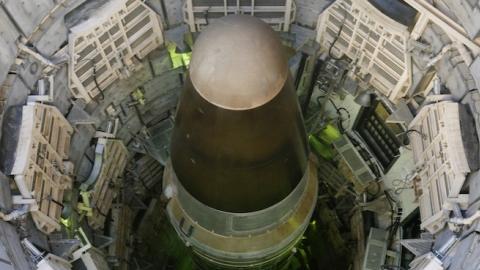The nuclear idealists in the Obama administration only have a few months left to weaken the U.S. nuclear deterrent by way of implementing a few more items on its "Prague Agenda." A new report at the Washington Post by Josh Rogin reveals that the Obama administration will seek a United Nations Security Council resolution banning nuclear testing as a way to bypass the U.S. Senate, which has long opposed committing the United States to a ban and precluding the option to resume testing should the reliability and credibility of the force require it. Avoiding the Senate to commit the United States to a ban, much like it avoided the Senate to secure the Iran deal, would be an egregious executive overreach and would go against the statements of intent from senior Obama administration officials.
For instance, undersecretary of state Rose Gottemoeller said, "Ratification of the CTBT will require debate, discussion, questions, briefings, trips to the National Labs and other technical facilities, hearings and more, as was the case with the New START Treaty...The Senators should have every opportunity to ask questions -- many, many questions -- until they are satisfied. That is how good policy is made and that is how treaties get across the finish line."
She's exactly right.
In addition to seeking a testing ban, the administration could also seek to undo decades-old U.S. nuclear policy. It could change the current U.S. nuclear policy from that of strategic ambiguity to an official "no first use" policy. The last NPR maintained strategic ambiguity. Dr. Keith Payne at the National Institute of Public Policy (NIPP) succinctly explains why the existing policy offers a more effective deterrent.
__The fatal flaw of the warm and progressive-sounding NFU proposal is that it tells would-be aggressors that they do not have to fear US nuclear retaliation even if they attack us or our allies with advanced conventional, chemical, and/or biological weapons. They would risk US nuclear retaliation only if they attack with nuclear weapons. As long as they use non-nuclear forces, a US NFU policy would provide aggressors with a free pass to avoid the risk now posed by the US nuclear deterrent.__
The administration could also drag its heels on getting two critical modernization programs successfully moving through the development and acquisition processes. But doing this, like circumventing the Senate for a testing ban, would directly contradict his senior State Department and Pentagon officials and flout strong-bipartisan support of both programs.
Undersecretary Rose Goettemoeller gave a home-run testimony before the Senate Armed Services Committee (the entire thing is worth a look), in which she should have finally put to rest the misguided belief that the new cruise missile will spur an arms race with Russia. She said "The Russians have already developed their next-generation nuclear-armed air-launched cruise missile, the KH-102, and have employed its conventional variant, the KH-101, in Syria. Any notion that LRSO is spurring on Russia's advanced cruise missile development is simply not borne out by the facts."
After this testimony it seemed clear that the United States was moving forward with the LRSO.
Appearing to confirm this, the Air Force recently announced that it is moving forward with both the LRSO and the GBSD.
Keeping GBSD on time is especially critical for ensuring the land-based leg of the triad is ready and reliable. Minuteman III was fielded in the 1970s with a lifespan of 10 years. More than 30 years later, there are now evident capability gaps. Its unique and complementary characteristics make it the backbone of the triad. It is daily "in use" by providing the country a 24 hour, 365-day deterrent. It offers the Commander in Chief an immediate response option and it promises a devastating response to any enemy that might wrongly determine attacking the United States with a nuclear weapon is worth the cost. And if the United States maintains high quantities of ICBMs, it changes the calculus in the minds of a nuclear aggressor. It is impervious against air defense systems and cannot ultimately be destroyed by rogue states. In other words, it would take a massive nuclear attack to eliminate the land-based leg, the only way to defeat the ICBM force is a direct nuclear attack on the US homeland. This raises the stakes and serves as a powerful deterrent to would-be attackers. Although not cheap, it is a comparative bargain and the most cost-effective leg of the triad.
Still, although the State Department testimony and Air Force announcement are encouraging, there are many steps along the acquisitions process and if the Obama administration isn't truly committed to seeing those programs succeed, it could drag its heels. And since the Obama administration has shown a willingness to go back on its policy commitments and go against statements of its own officials, it could derail those programs surreptitiously.
After years now of bipartisan consensus to fully invest in the triad, bipartisan consensus to move forward with the LRSO and GBSD, after the Obama administration maintained a policy of strategic ambiguity in the Nuclear Posture Review, and when the U.S. Senate is definitely opposed to a test ban treaty, the Obama administration should throw in the towel. It has done enough damage and the clock has all but run out. Any decisions about the country's nuclear deterrent should belong with the next President. On this, both parties in Congress should agree.














